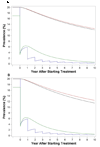DNA-based vaccines protect against zoonotic schistosomiasis in water buffalo
- PMID: 18524429
- PMCID: PMC2567122
- DOI: 10.1016/j.vaccine.2008.04.080
DNA-based vaccines protect against zoonotic schistosomiasis in water buffalo
Abstract
Schistosomiasis japonica is an endemic, zoonotic disease of major public health importance in China where water buffaloes account for approximately 75% of disease transmission. Interventions that reduce schistosome infection in water buffaloes will enhance their health simultaneously reducing disease transmission to humans. While chemotherapy has proved successful, it requires continued time consuming and expensive mass treatments. A more sustainable option would be development of vaccines that reduce transmission of S. japonicum from bovines to replace bovine chemotherapy. We performed two randomized double blind trials in water buffaloes to determine if DNA vaccines encoding triose-phosphate isomerase (SjCTPI), or the tetraspanin 23 kDa integral membrane protein (SjC23), alone or fused to bovine heat shock protein 70 (Hsp70) could induce a level of immunity conducive to long-term sustainable control. Groups of water buffaloes (15/group) received three intramuscular injections, 4 weeks apart. Booster immunizations were co-administered with a plasmid DNA encoding IL-12. Four weeks after the last injection, water buffaloes were challenged with 1000 cercariae, and vaccine efficacy analyzed 8 weeks later. Water buffaloes vaccinated with SjCTPI-Hsp70 or SjCTPI plasmids had worm burdens reduced by 51.2% and 41.5%, respectively. Importantly, fecal miracidial hatching was reduced by 52.1% and 33.2% respectively compared to control vaccinated water buffaloes. Vaccination with SjC23-Hsp70 and SjC23 plasmids reduced worm burdens by 50.9% and 45.5%, respectively, and fecal miracidial hatching by 52.0% and 47.4%. A mathematical model of schistosome transmission predicts that schistosome vaccines capable of reducing water buffaloes' fecal egg output by 45%, alone or in conjunction with praziquantel treatment, will lead to a significant reduction in transmission of schistosomiasis. Both DNA vaccines tested here exceed this hypothetical level. Indeed, mathematical modeling of SjCTPI-Hsp70 and SjC23-Hsp70 alone and in conjunction with human chemotherapy showed a significant reduction in transmission almost to the point of elimination.
Figures





References
-
- Chitsulo L, Loverde P, Engels D. Schistosomiasis-TDR/WHO. Nat Rev Microbiol. 2004;2(1):12–13. - PubMed
-
- King CH, Dickman K, Tisch DJ. Reassessment of the cost of chronic helmintic infection: a meta-analysis of disability-related outcomes in endemic schistosomiasis. Lancet. 2005;365(9470):1561–1569. - PubMed
-
- van der Werf MJ, de Vlas SJ, Brooker S, Looman CW, Nagelkerke NJ, Habbema JD, et al. Quantification of clinical morbidity associated with schistosome infection in sub-Saharan Africa. Acta Trop. 2003;86(2–3):125–139. - PubMed
-
- Williams GM, Sleigh AC, Li Y, Feng Z, Davis GM, Chen H, et al. Mathematical modelling of schistosomiasis japonica: comparison of control strategies in the People's Republic of China. Acta Trop. 2002;82(2):253–262. - PubMed
Publication types
MeSH terms
Substances
Grants and funding
LinkOut - more resources
Full Text Sources
Other Literature Sources
Medical

